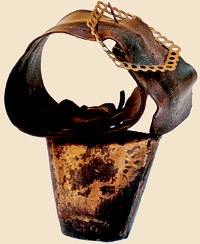Angela Czintelová
The town of Jelšava has a several hundred year tradition of producing tinkered tin bells. Their bell makers have been focused on creating bells from metal tin since the 16th century. In the beginning they were organized into guilds with smiths and locksmiths. Documentation about individual bell guilds dates back to 1852.
At the beginning of the 20th century there were around 35 to 40 bell making families in Jelšava. The bells were made to order for shepherds. The main market areas were in the Balkans – Bucharest, Brasov, Kluz, Sibiu, Beograd, but bells also headed out to Vienna, Debrecen etc. In the territory of current Slovakia they were sent to the areas of Michalovce, Bardejov and Liptov. Buyers (such as Schotz from Matejovce) ordered bells in such large amounts that it is presumed that they were transported further to Poland and Russia.
In connection with the changing state borders after 1918, with the diminishing green pastures and change from cattle being outside to inside, bell-making in Jelšava started to cease. After WWI only one family, the Kenereš family, made the well-known Jelšava bells. WWII completely stopped this developing craft, and after it bell-making could no longer find its way. The masters died and there were no followers. The last bell maker in Jelšava was Ľudovít Kenereš.
A Gemer speciality were tin tinkered bells that weighted from 0.5 to 6 kg. The most common were bells for sheep and cows. Approximately 90 types of bells were made in Jelšava. They were from metal or brass tin.
The last active Gemer bell maker, who made bells mainly for shepherds and cooperative farms, was Ľudovít Bastyúr from Silica (died in 1994), the son of a tinker smith. His son, Vojtech, continues the tradition – he used to make bells as souvenirs and only in small numbers to order for shepherds. Recently his grandson Jaroslav has become active in this craft, and he demonstrates bells during various events and markets.
